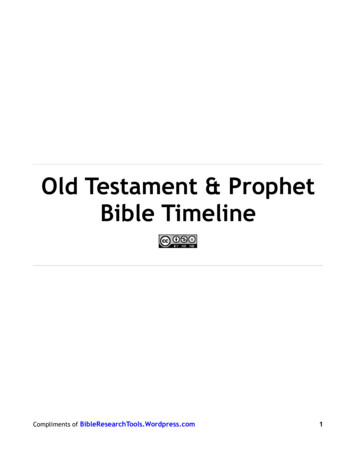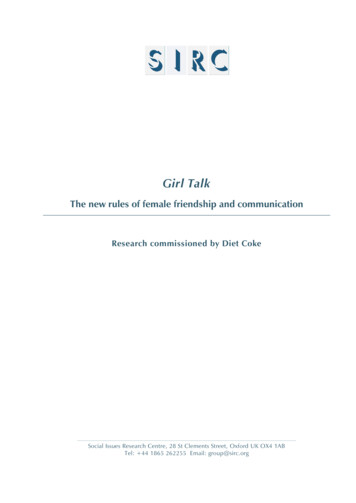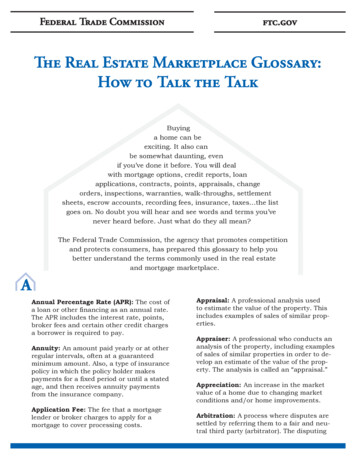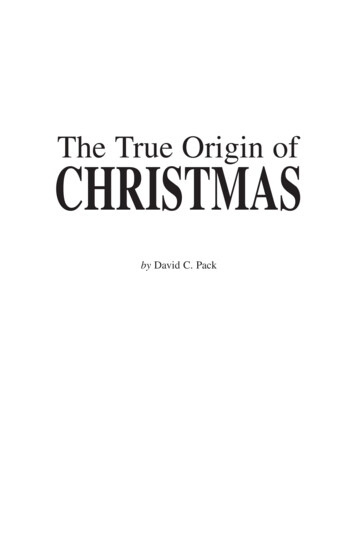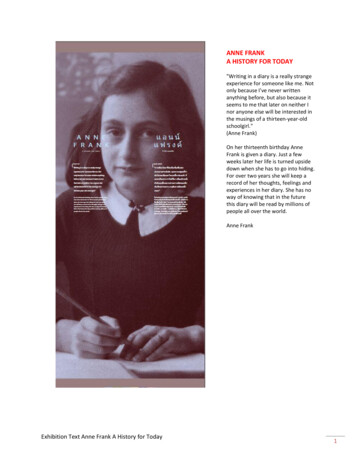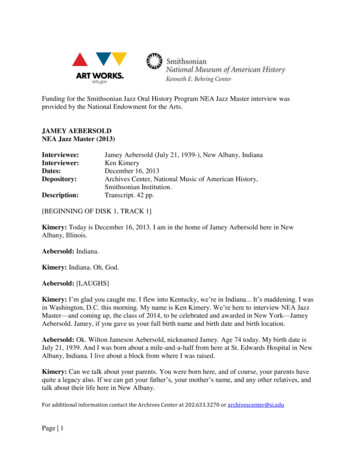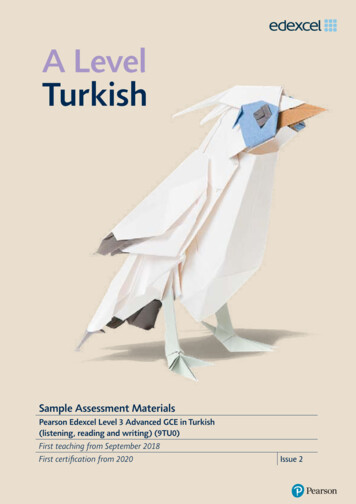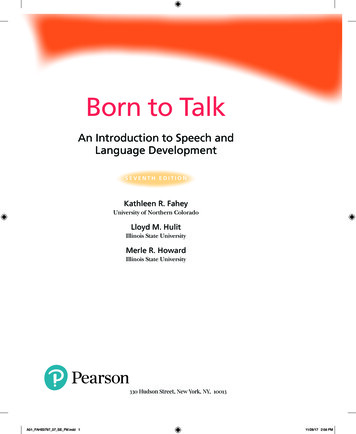
Transcription
Born to TalkAn Introduction to Speech andLanguage DevelopmentSEVENTH EDITIONKathleen R. FaheyUniversity of Northern ColoradoLloyd M. HulitIllinois State UniversityMerle R. HowardIllinois State University330 Hudson Street, New York, NY, 10013A01 FAHE0797 07 SE FM.indd 111/28/17 2:56 PM
Director and Publisher: Kevin DavisExecutive Portfolio Manager: Julie PetersManaging Content Producer: Megan MoffoContent Producer: Faraz Sharique AliPortfolio Management Assistant: Maria Feliberty andCasey CoriellDevelopment Editor: Krista SlavicekExecutive Product Marketing Manager: Christopher BarryExecutive Field Marketing Manager: Krista ClarkManufacturing Buyer: Deidra SmithCover Design: Carie Keller, CenveoCover Photo: FatCamera/E /Getty ImagesMedia Producer: Autumn BensonEditorial Production and Composition Services:SPi Global, Inc.Editorial Project Manager: Jennylyn Rosiento, SPi GlobalFull-Service Project Manager: Mohamed HameedText Font: New Baskerville ITC ProCredits and acknowledgments borrowed from other sources and reproduced, with permission,in this textbook appear on the appropriate page within text or on this page.Photo Credits: Page 1, Jupiterimages/BananaStock/Getty Images; Page 27, Syda Productions/Shutterstock; Page 62,Comstock Images/Stockbyte/Getty Images; Page 113, Michaeljung/Shutterstock; Page 180, Jules Selmes/PearsonEducation, Inc.; Page 209, Comstock/Stockbyte/Getty images; Page 263, Jupiterimages/Pixland/Getty Images; Page 323,Sergey Novikov/Shutterstock; Page 363, FatCamera/Vetta/Getty Images; Page 393, Photodisc/Getty ImagesCopyright 2019, 2015, 2011 by Pearson Education, Inc. or its affiliates. All Rights Reserved. Manufactured in the UnitedStates of America. This publication is protected by copyright, and permission should be obtained from the p ublisher priorto any prohibited reproduction, storage in a retrieval system, or transmission in any form or by any means, e lectronic,mechanical, photocopying, recording, or otherwise. For information regarding permissions, request forms, and the appropriate contacts within the Pearson Education Global Rights and Permissions department, please visitwww.pearsoned.com/permissions/.PEARSON and ALWAYS LEARNING are exclusive trademarks owned by Pearson Education, Inc. or its affiliates in theU.S. and/or other countries.Unless otherwise indicated herein, any third-party trademarks, logos, or icons that may appear in this work are the property of their respective owners, and any references to third-party trademarks, logos, icons, or other trade dress arefor demonstrative or descriptive purposes only. Such references are not intended to imply any sponsorship, endorsement,authorization, or promotion of Pearson’s products by the owners of such marks, or any relationship between the ownerand Pearson Education, Inc., or its affiliates, authors, licensees, or distributors.Library of Congress Cataloging-in-Publication DataNames: Fahey, Kathleen R., author. Hulit, Lloyd M., author. Howard, MerleR., author.Title: Born to talk : an introduction to speech and language development /Kathleen R. Fahey, Lloyd M. Hulit, Merle R. Howard.Description: Seventh edition. Boston : Pearson, [2017] Lloyd M. Hulit’sname appears first in the previous edition. Includes bibliographicalreferences and indexes.Identifiers: LCCN 2017040177 ISBN 9780134760797 ISBN 0134760794Subjects: MESH: Language Development SpeechClassification: LCC P118 NLM WS 105.5.C8 DDC 401/.93--dc23 LC record available at https://lccn.loc.gov/2017040177ISBN 10: 0-13-476079-4ISBN 13: 978-0-13-476079-7A01 FAHE0797 07 SE FM.indd 211/28/17 2:56 PM
About the AuthorsKathleen R. Fahey, Ph.D., was born in Parma Heights, Ohio. She received her bachelor’s, master’s, and doctoral degrees from Bowling Green State University, Kent StateUniversity, and Michigan State University, respectively. She is professor emeritus at theUniversity of Northern Colorado. She is a speech-language pathologist with 40 years’experience in the assessment and intervention of childhood speech, language, and literacy disorders. Her areas of expertise include development and disorders ofarticulation and phonology, early language, and school-age language and literacy.She currently teaches undergraduate and graduate courses in an online format atthe University of Northern Colorado. Kathleen is also the clinical editor of speech- language pathology and audiology for OnCourseLearning.com.Lloyd M. Hulit, Ph.D., was born in Ashland, Ohio, and lived in several Ohio townsbefore his father was hired by the U.S. Agency for International Development to assistforeign departments of education establish vocational education programs in theircountries. Dr. Hulit attended high school in Seoul, South Korea, and while his f amilylived in Benghazi, Libya, he attended the Schutz American School in A lexandria, Egypt,graduating in 1963. He attended the University of Maryland’s branch in Munich, Germany. He completed his undergraduate degree, graduating magna cum laude, at Ashland (Ohio) College, with a major in speech communication and a minor in Biblestudies as part of pre-seminary training. He earned his M.A. and Ph.D. at The OhioState University with a major in speech and hearing science and a minor in instructionaltechnology. Before attending graduate school, Dr. Hulit taught at the high school andelementary school levels and was a licensed lay minister in the Evangelical UnitedBrethren Church. He taught at Illinois State University in Normal, Illinois, for morethan 30 years. He is the author of 14 journal articles and published papers. In addition to being the senior author of Born to Talk, he is the sole author of three textbookson stuttering: Stuttering Therapy: A Guide to the Charles Van Riper Approach, Stuttering in Perspective, and Straight Talk on Stuttering, now in its second edition. Dr. Hulit’s professional passion was teaching. His specialties were fluency disorders, phonological disorders, and language development. Among many teaching awards, he was twice namedProfessor of the Year by his department, was awarded the Distinguished Teaching Awardby ISU’s College of Arts and Sciences, the Burlington Northern Foundation Award,and the American Speech and Hearing Association’s Golden Apple Award. Dr. Hulitis married to the former Pamela Immel of Massillon, Ohio. He is the father of twoextraordinary daughters, and grandfather to five beautiful and exceptionally brilliantgrandchildren. In retirement, he continues another passion of his life, coaching highschool and junior high school baseball, a career that now spans more than 40 years.Dedicated to Merle R. Howard, Ph.D.The seventh edition of Born to Talk is dedicated to the memory of Merle R. Howard,one of the original authors of this textbook, an outstanding teacher, a man of immeasurable personal skills, and a giant in my life as a respected colleague and belovedfriend. Merle died on July 8, 2013, after a determined and courageous three-year battleagainst leukemia.The first edition of this book was published in 1993, and while 20 years will seemlike ancient history to most who read it, this book was actually a topic of discussionA01 FAHE0797 07 SE FM.indd 3 iii 11/28/17 2:56 PM
iv About the Authorsbetween Merle and me for more than 10 years before we actually put ink to paper andkeystrokes to computer files. We had both taught a course at Illinois State Universitytitled Human Verbal Development, a course designed for nonmajors who needed a background in speech and language development. Most of the students enrolled in thiscourse were early childhood, elementary, and special education majors, but the coursewas a popular general education elective that attracted students from every conceivable major offered by the university. We loved teaching the course, but we were frustrated that we could not find a textbook that matched the needs of our students. Over coffee—well, coffee for Merle and diet soda for me—we talked about the possibility ofwriting our own textbook. The first conversations began about 1980. It was a subjectwe dropped and resurrected a number of times, depending on how the Chicago Cubswere faring in a given year, but about 1986, we decided to take a serious run at it. Oneof the publishers that eventually became part of Pearson visited our campus. We talkedto a representative and shared an outline of what we had in mind. Her response wasunconditionally enthusiastic, so we developed a plan of action that resulted in a bookthat is now an important part of Merle Howard’s professional legacy.Merle was born on August 12, 1939, in West Frankfort, Illinois. He earned B.S. andM.S. degrees at Southern Illinois University. His bachelor’s degree was in speech andpublic address. His master’s degree was in speech pathology and audiology. He earnedhis Ph.D. in speech pathology at the University of Cincinnati. His doctoral researchand his dissertation focused on stuttering.Merle’s professional career began and ended at Illinois State University in Normal,Illinois, a career spanning 35 years. At the close of his career, Merle was the directorof the ISU Speech and Hearing Clinic, but his passion was always teaching. Duringhis tenure at ISU, he taught a wider array of courses than any other member of thefaculty, but his favorite area was neuropathology. He had the extraordinary ability tomake this detailed and complex subject understandable to even the most befuddledstudents, and they loved him for it. He was a demanding teacher, but he placed hisgreatest demands on himself to make sure that students in his classes understood whatthey needed to know about every subject he taught.Outside of his professional life, Merle was an excellent golfer. He rode a trail bikewith friends, and he spent a lot of time on his prized Harley Davidson. His favoritemusic was jazz, an interest intensified by his own talents playing the trumpet and byhis participation as a member of The Tempos, a 14-piece jazz band at Southern IllinoisUniversity, a diversion he enjoyed during his years there as a student. Merle was married to Bonita for 50 years, and he was the father of one son, Lane.Merle was an impressive and widely appreciated presence in this world, as a husband, a father, a friend, a colleague, and a co-author. To know Merle was to love him. Itwas Will Rogers who famously said, “A stranger is just a friend I haven’t met yet.” Thattoo was Merle Howard. He had an incredible capacity for remembering people andtheir names. More importantly, he remembered their interests and facts about theirlives. He was the quintessential people person.Merle was rightly proud of Born to Talk. His contributions to this book over the yearshave been incalculable. I was honored to work with him on this project, but I was evenmore honored to be his friend. To say that I will miss him does not do justice to thevoid his passing has left in my life, but his influence will remain with me until I tooturn my final page.Lloyd M. Hulit, Ph.D.Professor Emeritus, Illinois State UniversityA01 FAHE0797 07 SE FM.indd 411/28/17 2:56 PM
ContentsPrefacexiChapter 1 A Connection of Brains1Defining Communication, Language, and Speech 2Speech and Language Rejoined 8The Unique Characteristics of Human Speech 8From Mouths to Ears 10 Sending and Receiving Signals 11 Hear Today,Gone Immediately 12 I Said it and I Meant It 13 Speech Is for Talking and Listening 14 Because We Say So! 14 The Limits of Speech 15 Born toTalk 15 If You Can Say It, I Can Say It 16 Sending Messages Loudand Clear 16 The Creativity of the Mind and Mouth 18 Back to theFuture 19 Many Wholes From a Few Parts 19 I Think, Therefore I Am 20Speaking Is an Art Form 20 Talking About Talking 21 Recipe for Language 21 Not All Features Are Created Equal 21Speech: The Tale of Two Brains 22Summary 25Surfing the Web 26Chapter Review 26Chapter 2 Language Acquisition: A Theoretical Journey27The Nativist Theories of Language Acquisition 27Human Biology and Language 29 The Extreme View of Nature’s Contribution to Language Development 33The Behaviorist Theory of Language Acquisition 40Speech and Language as Operant Behaviors 41Interactionist Theories of Language Acquisition 46Interactionist Interpretations 48 New Perspectives in Language Acquisition 59Summary 61Surfing the Web 61Chapter Review 61Chapter 3 Cognitive Development: Building a Foundation for Language62Piaget’s Theory of Cognitive Development 64The Elements and Processes of Cognitive Organization 64 The Stage Conceptof Cognitive Development 66 The Principle of Distancing in S ensorimotor v A01 FAHE0797 07 SE FM.indd 511/28/17 2:56 PM
vi Contents evelopment 67 Concepts and Behaviors Central to Early CognitiveD Development 68 The Sensorimotor Period (Birth to Two Years) 72Recent Research: A Critical Review of Piaget’s Sensorimotor Stage 83 Piaget’s HigherCognitive Stages 85Sociocultural Perspectives of Cognitive Development 89Vygotsky’s Theory 89 Private Speech 91 Social Keys to Cognitive Development 92Second Learning Outcome: dynamic systems theory 94The Perceptual Groundwork for Communication 96The Relationship Between Perception and Cognition 97 Visual and Tactile Perception 97 Auditory Perception 99 Executive Functions 103 Attentionand Memory 104 Executive Functioning and Bilingual Acquisition 105 ExecutiveFunctioning and Theory of Mind 106Cognition, Language, and Literacy Development 108Cognition and a Second Language: Two Views 109Summary 111Surfing the Web 112Chapter Review 112Chapter 4 In the Beginning: Communication Development from Birth to2 Years 113Social and Cultural Factors in the Language Learning Environment 114Social Class, Education, and Occupation 115 The Impact of Socioeconomic Status onLanguage and Learning 118Parent-Infant Communication Prior to and After Birth 120Creating a Communication Environment: Social Routines Involving Songs, Rhymes, andStories 121Child-Directed Interactions 124Expansions and Extensions 129The Right Stuff for Nurturing Language 132Child-Directed Speech Matters 133Variability in Amount of Interaction 135Predictability of Language Growth 137Impact of the Language Environment on Language Growth 141Applicability of Child/Adult Interaction Data to Children with Disabilities 142Ready for Language: Infants’ Early Comprehension and Expression 146Perception and Comprehension of Words 146Prelinguistic Vocalizations: Sounds of Distress, Comfort, and Pleasure 150Transitional and True Babbling 151 Variegated Babbling and Jargon 152 UsingCommunication to Get Things Done 153Beyond Infancy: The Emergence of First Words 157A01 FAHE0797 07 SE FM.indd 611/28/17 2:56 PM
Contents vii First Words 157Classifying the Child’s First Words 158 Presuppositions and Conversational Turn Taking 164 Midstage Review: What Is Happening So Far? 165Early Syntactic Development: A Stage Model 166Early Stage 1 (MLU: 1.0 to 1.5; Age: 12 to 22 Months) 168 Late Stage 1: Syntactic Development—Words to Word Combinations (MLU: 1.5 to 2.0; Age: 22 to 26Months) 169 The Syntactic Level: Arranging Words Appropriately 170 The Semantic Level: D etermining the Meanings of Early Sentences 171 The PragmaticLevel: An Emphasis on the Functions of Early Sentences 173Comprehension and Production: A Critical and Evolving Relationship 174Summary 177Surfing the Web 179Chapter Review 179Chapter 5 Children Learning Language: Participating in LanguageSamples 180Purposes of Language Sampling 181Obtaining Reliable and Valid Language Samples 182Facilitating Interaction 183Recording the Language Sample 184 Transcribing the Sample 184Analyzing the Language Sample 185Grammatical Analysis 186 Semantic Analysis 189 Pragmatic Analysis 190Sample Analysis and Interpretation 191Summary 195Surfing the Web 195Chapter Review 195Appendix A: Sample Language Transcription Form 196Appendix B: Sample Language Transcript: Three-Year-Old Child 197Appendix C: Language Sample Transcription—Counting Morphemes 200Appendix D: Language Sample T ranscription and Grammar Analysis 203Appendix E: Sample Language Transcription Form—Eric 206Chapter 6 The Saga Continues: Language Development Through the Preschool Years 209Mean Length of Utterances in Stages 2 and 3: Elaborating Structure 210Pronouns: Words Used to Represent Nouns 212 AuxiliaryVerbs 215 Phrases 215 Negation 217 Asking Questions 219 Requestsand Demands 220A01 FAHE0797 07 SE FM.indd 711/28/17 2:56 PM
viii ContentsRefining Meaning in Stages 2 and 3: Semantics, Pragmatics, Conversations, andMetalinguistics 221Pragmatics and Conversation 223 Metalinguistics 226Mean Length of Utterances in Stages 4 and 5: Elaboration with Phrases and Clauses andPolishing the Act 229Morphology, Pronouns, Verbs, Negation, and Questions 230 Phrases WithinClauses 233 Embedding and Conjoining Sentences 235 Pragmatics, Conversations,and Narratives 236Metalinguistics and Emergent Literacy 242The Role of Comprehension and Production in Language Development 248Concepts Underlying Words 248 Active and Passive Sentences 250 FigurativeLanguage 251Learning More Than One Language 252Bilingualism 252 Simultaneous Language Acquisition 253 Two Languages or a Hybrid? 254 The Impact of the Community on S imultaneous Bilingualism 255 Monolingual Versus Simultaneous Bilingual Development 255 CodeMixing 256 Stages of D evelopment in Simultaneous B ilingualism 257 SuccessiveBilingual Language Development 257 Transfer from First to Second Language 258 Influence of the Second Language on the First 258 Stages ofDevelopment in Successive Bilingualism 259 The Optimal Age of Second LanguageLearning 261Summary 262And That’s Not All, Folks! 262Surfing the Web 262Chapter Review 262Chapter 7 Taking Language from Home to School263The Classroom and Language: New Demands in Diverse Settings 265Cultural Diversity in the Classroom 265 Teacher Preparation, Classroom Environment,and Curricular Approaches 267The Language Forms and Curricula of the Classroom 271Teacher/Student Dialogues: Basic Variations 272Semantic Development 274Factors Influencing Vocabulary Acquisition 275 Storing, O rganizing, and RetrievingVocabulary 277 Learning to Define Words 280 Having Fun with Words: Literal toFigurative Forms 282Syntax and Morphology 286Figuring Out Passive Sentences 286 The Principle of M inimal Distance 286 Conjoining and Embedding: B ecoming More Complex 287 Noun and Verb Phrases: Still Expanding 290 Morphological Modifications 292A01 FAHE0797 07 SE FM.indd 811/28/17 2:56 PM
Contents ix Conversations and Narratives 294Topic Maintenance and Presupposition 294 Indirect Requests 295 Conjuncts andDisjuncts 296 Gender Differences in Conversations 297Narratives 300Metalinguistics and the Development of Reading and Writing 303Awareness of Speech Sounds 303 Awareness of Semantics 304 Awareness of Morphology and Syntax 305 Awareness of Pragmatics 305 Learning to Read andWrite 307 The Components of Reading and Reading Instruction 307 Children’sReading Development 308 Components of Writing and Its Development 313 Andthe Beat Goes On . . . 321Summary 322Surfing the Web 322Chapter Review 322Chapter 8 Development of Speech Sounds and Cultural Variations in Speechand Language Production 323Describing Speech Sounds 325Traditional Phonetics 326 Distinctive Features 329Development of Speech Sounds in the Prelinguistic and One-Word Stages 330Development of Speech Sounds in Two-Word Utterances and Beyond 335Consonant Clusters 336 Intelligibility 336Phonological Views of Development 337Coarticulation and Suprasegmental Aspects of Speech Production 340Cultural Variations in Speech and Language Production 343Dialects and Accents 344 Social/Cultural Dialects 345Regional Dialects 357Summary 361Surfing the Web 362Chapter Review 362Chapter 9 Speech and Language Disorders in the Home, School,and Community 363Defining Communication Disorders 363Interrelationships and Impact of Speech and Language Disorders 368Four Students with Speech, Language, and Learning Problems 368Causes and Types of Communication Disorders 372Environmental Factors 373 Sensory Factors 374 Developmental Factors 376Neurological Factors 379A01 FAHE0797 07 SE FM.indd 911/28/17 2:56 PM
x ContentsLanguage Disorders of Unknown Origin 383Speech Disorders 384Articulation Disorders 385 Voice DisordersFluency Disorders 386Summary 389Final Thoughts 390Surfing the Web 390Chapter Review 391385Chapter 10 The Anatomical and Physiological Bases of Speech, Language,and Hearing 393Speech as the Product of Borrowed Structures: Four Processes of Speech 393Respiration 396Phonation 400Resonation 405Articulation 406The Brain: The Computer Center for Speech and Language 408Speech and Language Functions of the Brain 410The Ear: An Energy Transformer 414The Outer Ear 414 The Middle Ear 414 The Inner Ear 416 Tracing the Pathway of Hearing: A Brief Summary 418Summary 419Surfing the Web 419Chapter Review 419Glossary 420References and Suggested ReadingsName Index 480Subject Index 485A01 FAHE0797 07 SE FM.indd 1043311/28/17 2:56 PM
PrefacePractitioners and researchers from many disciplines continue to contributenew and exciting information about human language acquisition. It is challenging to keep abreast of the complex array of topics that provides the foundation for human communication and its development from birth throughthe young adult period. This new edition of Born to Talk is suitable for studentsand practitioners in speech-language pathology, early childhood education,general education, special education, and related disciplines who seek a contemporary and comprehensive view of speech and language development ina reader-friendly manner.New to This EditionThe eText for this title is an affordable, interactive version of the print text thatincludes videos and interactive features that provide opportunities for studentsto get feedback on their answers to the questions posed.To learn more about the enhanced Pearson eText, go to:www.pearsonhighered.com/etextbooks.New to This EditionThis edition is again available in a digital format. The seventh edition providesnot only review opportunities but also application opportunities to deepenunderstanding. Several Video Examples in each chapter allow readers to see and hearcontent and examples that enhance learning of key concepts. Studentsread a brief description of what the video is about and watch a video thatdemonstrates the concept.The Video Reflection feature gives readers access to a video, a thoughtprovoking question that pops up from the eText, a hint for thinkingabout the answer, and a write-in area into which students apply contentby typing a written response. Detailed feedback is provided after studentssubmit their written response, thereby immediately providing the correctanswer.At the end of each major section of text, students have access to a briefsection quiz, called Check Your Understanding. The quiz checks comprehension of main concepts and feedback is available for each answer.At the end of each chapter, students have access to the Chapter Review.Feedback is available for each of these short essay format or short-answerquestions. xi A01 FAHE0797 07 SE FM.indd 1111/28/17 2:56 PM
xii Preface A glossary is included in this edition that provides definitions for keyterms in the text. These terms appear in boldface when they are firstmentioned. In the eText, readers can click on the term to directly accessthe glossary.Search terms in Surfing the Web sections at the end of each chapterencourage readers to expand their knowledge beyond the text to practical and interactive application of the concepts. The search terms providea vehicle for extended learning opportunities for students in a multimedia context.In addition, in this seventh edition of Born to Talk, we have Added new information and reorganized information in Chapter 4 aboutthe early language environment of parents and infants.Reduced language examples and figures in Chapter 4 regarding differences in talkative versus taciturn parents, making the remaining examplesthe focus of the important concepts underlying their use.Added a new chapter (Chapter 5) on language sampling that ties Chapter4, about the one-word stage, to Chapter 6, regarding the development ofsyntax. Chapter 5 introduces and explains the process of eliciting, transcribing, analyzing, and interpreting language samples. These processesare useful for readers as they learn about the language gains childrenmake.Added examples and worksheets to Chapter 5 to encourage practice inlanguage sampling.Reorganized the information in Chapter 6 to discuss the language attainment into two, rather than four sections: Stages 2 and 3, followed byStages 4 and 5.Integrated all the information about language/cultural diversity, including social and regional dialects, bilingualism, and diversity in schools,into other chapters.About This TextThe primary focus of this book is on language development. The sole purposeof Chapter 1 (“A Connection of Brains”) is to pique the reader’s interest inlanguage as a unique human experience and to increase appreciation of howmessages are transmitted from one human brain to another. Chapter 2 lays thegroundwork for considering the impressive nature and nurture of human communication. We discuss the many perspectives involved in learning language byexploring what human communication is and how we learn it during our earlyyears. In this edition, we also relate the three perspectives—nativist, behaviorist, and social interactionist—to how speech-language pathologists and educators use them in designing appropriate goals and intervention strategiesfor children with typical and atypical language development. Chapter 3 is anexploration of how the development of cognition and perception is relatedA01 FAHE0797 07 SE FM.indd 1211/28/17 2:56 PM
Preface xiii to language learning. In Chapter 4 we begin the journey of early interactions of parents and children that lay the foundation for language acquisitionthrough the one-word stage. In Chapter 5 the process of language sampling isdescribed, to help readers appreciate how language development is describedand documented. Chapter 6 is a continuation of the stage model to present thejourney each child takes in developing the various components of language.Chapter 7 shows how the integration of all language components, includingliteracy, using this real-time approach facilitates an understanding of how oneaspect of language affects all other aspects. Chapter 8 explores how languageis learned and transmitted from one person to another via speech productionand how social and regional dialects influence speech and language. Chapter9 provides a brief overview of developmental and acquired disorders of speechand language. Some readers will be less familiar than others with informationpertaining to the anatomy and physiology of speech, language, and hearing.We include this information in the Chapter 10.Before we get to our acknowledgments, we want to address the genderstrategy we use in this book. As members of a profession that is more than 80%female, we are sensitive to the gender problem in communication. We are alsofrustrated by the limitations of American English pronouns. For this reason, wealternate the use of feminine and masculine pronouns, with the understandingthat these pronouns are intended to be gender-neutral in all contexts. We alsogenerally refer to the child in the singular (versus the plural children) in orderto create an image of one child whose speech and language development westudy through this book.There are occasional personal references in this book, indicated by firstperson pronouns and by phrases such as: my sister, daughter, grandchildren, andfather. These references reflect the life experiences of the authors, and each isfootnoted for the reader’s information.AcknowledgmentsWe are grateful for the invaluable contributions of several people. Pamela Hulitprovided computer assistance in creating a number of tables included in thebook. Dr. Jill Gilkerson from the LENA Research Foundation provided guidance in the selection of figures from LENA publications and language samplesfrom its database. Lori Shin from the LENA Research Foundation tailored thegraphic art to meet publication specifications. Taylor Weber, a graduate student in speech-language pathology from the University of Northern Colorado(UNC), assisted with the video project and created the glossary. Andy Nagel,the videographer from Mirage Video Pro, and his assistant Ian worked with usin a university and public school setting to produce the videos. We appreciatethe special talents of these people, and we are grateful for their efforts on ourbehalf.A special thank you is extended to the parents and their children who graciously gave their time and language interactions to the video project, Dr. Madeline Milian for her interview about learning English as a second language andA01 FAHE0797 07 SE FM.indd 1311/28/17 2:56 PM
xiv Prefacebilingual education, and Carol Haworth for her coordination extraordinaireand expert speech-language pathology services in the school.Finally, we thank the following people who reviewed the sixth edition of thisbook: Robin Danzak, Sacred Heart University; Stephanie Hughes, Universityof Toledo; Michelle Ivey, University of Houston; Donna Thomas, SoutheasternLouisiana University.To the most important people in our lives,with immeasurable love and gratitudePamela, Yvonne, Carmen, Scot, John, Christopher,Lance, Benjamin, Peyton, Brianna, Bonita, Lane, Cornelia,Rosemary, Ernest, Daniel, Anna, Molly, Andrew, and SamanthaA01 FAHE0797 07 SE FM.indd 1411/28/17 2:56 PM
Outside of his professional life, Merle was an excellent golfer. He rode a trail bike with friends, and he spent a lot of time on his prized Harley Davidson. His favorite music was jazz, an interest intensified by his own talents playing the trumpet and by his participation as a member
